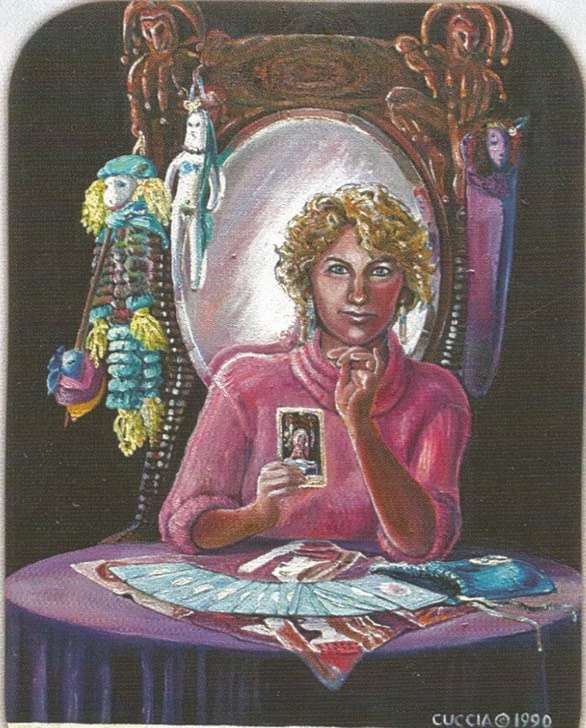By Wayne Limberger
Image of the Fool from the Ancestral Path Tarot by Julie Cuccia-Watts, published by U.S. Games Systems, Inc.
There is a punch line from an old and very non-PC joke, (for which I apologize without revealing any more) and a response from John Lennon's book In His Own Write, that together neatly summarize all we think we know about the inner workings of a tarot reading.
Q: “How do it know?”
A: “You might well arsk.”
There are several major themes that dominate the discussion among experienced readers regarding how tarot gets to the heart of a matter and yields useful information. One prominent theory is that it's a form of psychic linkage between querent and reader that imparts hidden wisdom to the reader's hands in shuffling, cutting and pulling the cards (although it's usually couched in more flowery "We-Are-All-One" New Age platitudes). This one is popular among on-line readers who seldom have a "live" connection to their clients and those face-to-face readers who can't abide other people touching their cards. Other readers insist that they are privy to divine inspiration and that neither they nor the client psychically intervenes in forming the judgment. More psychological readers peg it to universal knowledge stored in the collective unconscious, a boundless source from which specific insights are channeled via the reader's subconscious. But by far the largest group just says "It works and I don't care how." The touchstone and inevitable fall-back when posed this question is "I trust my intuition." Although positive results are almost unanimously reported, evidence of accuracy is for the most part anecdotal.
Those who work face-to-face with their clients (myself included) have a slightly broader palette with which to paint. When the client is physically present, he or she can actively participate in arranging the cards in the sequence most appropriate for seamless and meaningful interpretation. Most clients are amenable to shuffling and cutting the deck, while those who are leery of shuffling will usually perform the cut. This degree of client engagement instills some ownership in the outcome and relieves the reader of that unilateral obligation. Since clients are imparting order to the cards with their own hands, the apparent mode of “insertion” takes the form of “subconscious induction” untainted by any preconceptions or personal bias that might intrude through the reader's involvement.
Having the client in the room also enables the overworked concept of "intuition to be replaced by the other three "I" words - Imagination, Inspiration, and Ingenuity – leading to the "Grand I," Insight. The client can expedite this infusion of the storyteller's art by offering observations and immediate feedback on the relevance of any statements made by the reader. This removes some of the anecdotal "sloppiness" from the reading and edges it a little closer to empirical legitimacy. Some readers claim that their clients sit there like statues and never say a word; this seems to be unusually common among readers in reserved, class-conscious cultures like India. In my experience as an American reader, most people are more than willing to talk about themselves if pointed down the right path. Succeeding in this encouragement becomes a fine point of the tarot reader's art. The reader's style has much to do with success in opening the client up to dialogue. A reader who is enthusiastic and gregarious will generally fare better than one who is solemn and measured in approach. My goal as a reader is to engage the client fully and always keep things moving forward, never dwelling on any single card for too long unless it's the central theme of the entire narrative. Even then, I'm prone to continue on to the end and circle back to re-emphasize key points as part of the closing.
Another series of quotes (there are many profound ones) from one of my favorite tarot writers, Joseph Maxwell, describes it thus:
“Harnessing the restless steeds of the intuition and making them do their work properly is the seer's principal difficulty. To do this, it is necessary to form a picture of how the sitter's thoughts and feelings affect him, or her, in order of importance or intensity.
The sitter usually needs help to do this, and the best method is to inspect the spread of cards and then, in the way taught by experience and inspiration, give a general outline of the probabilities. Specific orientation occurs when observation of the sitter shows some matter of importance has been touched.
Where any violent emotion or movement of the soul is involved, it is necessary to know what species it is – love, greed, revenge, spiritual aspirations and so on.
Intuition is a good guide, but in the interest of making a full and helpful divination, it is necessary to verify with the enquirer at each step if the intuition is taking the right path.”
The bottom line for me is that the Jungian flavor of the "subconscious induction" model rings most true as a vehicle for the effective pursuit of foreknowledge via the tarot cards. Other methods give the impression of clairvoyance more than cartomancy and disassociate the client from direct responsibility for the outcome. You can say all you want to your clients about "free will" being the key to making the most of their readings, and that nothing is carved in stone, but you can't beat having them take a hand in actually setting the stage for the experience.
